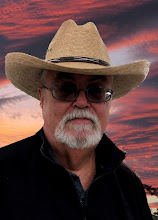This is a pulp that I own and read recently. That’s my copy in the scan, with another fantastic cover by Sam Cherry. He was really at his peak during this era. Earlier this year when I reviewed the April 1950 issue of TEXAS RANGERS, one of the members of the WesternPulps email group commented that the Jim Hatfield novel in it, “The Rimrock Raiders”, sounded similar to the Hatfield novel in the March 1948 issue, “The Black Gold Secret”. So I had to find my copy and read that one, too. Now I have.
“The Black Gold Secret” and “The Rimrock Raiders” are both by A. Leslie Scott
writing under the Jackson Cole house-name, so it’s not surprising that they’re
similar. The basic concept—clashes between cattlemen and oil drillers who have
moved into what was previously a ranching area—are the same, and Scott used
that plot foundation in other novels, as well. But the details in “The Black
Gold Secret” are different and it’s an equally entertaining yarn. Early on in
this one, Hatfield extinguishes a burning oil well, something that he also does
in “The Rimrock Raiders”, but does so in a totally different manner—and it
makes for a slam-bang, very exciting scene, too. Scott layers in some geology
and behind-the-scenes stuff about the oil industry and also provides plenty of
shootouts and fistfights along the way. The vivid descriptions that are a Scott
trademark are there but rather limited, as he keeps this one really racing
along. Of course, there’s more going on than is apparent at first, but you know
Hatfield will untangle all the villainy by the end, and it’s a pretty
spectacular climax, too, as the main bad guy meets his end in an unexpected
way. I had a great time reading this novel, and I’m sure I’ll be reading
another by Scott before too much longer.
Tom Parsons was a Thrilling Group house-name, so there’s no telling who wrote “Gun
Trail”, a short-short about a Texas Ranger doggedly tracking down a horse thief
and murderer, only to find that things aren’t exactly what he thought they
were. There’s not a lot to this story, but it’s short and punchy and enjoyable.
I started out not liking Joseph Chadwick’s work very much, but he’s won me over
and become one of my favorite Western writers. I think he’s one of the best of
the more hardboiled Western authors who rose to prominence in the postwar
years. His novelette in this issue, “The Blizzard and the Banker”, is
excellent. It’s about a small town in Dakota Territory trying to survive a hard
winter. The local banker is the hero of a Western story, for a nice change, but
there are several other good characters including an outlaw who’s maybe not
quite as bad as his reputation would have you believe, a beautiful female faro
dealer, and assorted villains. Chadwick does a fine job with the interactions
of these characters as well as his depictions of the harsh weather. Just a
really, really good story all the way around.
Allan K. Echols was one of those workmanlike writers who filled up the pages of
Western, detective, and aviation pulps with hundreds of stories during a 30-year
career (mid-Twenties to mid-Fifties; he passed away in 1953 but still had new
stories coming out a couple of years later). He also wrote more than a dozen
Western novels. And yet I’ve never run across anybody who proclaims themselves
a big Allan K. Echols fan. His story in this issue, “Brother’s Keeper”, is an
unacknowledged reprint from the January 1938 issue of ROMANTIC WESTERN. It’s
not romantic at all, though. Instead, it’s about an apparently dull-witted
sheriff who’s trying to figure out which of two rancher brothers is responsible
for the murder of one of their enemies. It’s a well-written, solidly plotted
story, and I enjoyed it, but I doubt that it’ll stick with me. Which probably
helps to explain why Echols is pretty much forgotten even among devoted Western
readers.
There’s also a Doc Swap story by Ben Frank in this issue. I’m sorry, but I didn’t
even try to read it. I used to say that the Swap and Whopper stories by Syl
McDowell in THRILLING WESTERN were my least favorite Western pulp series, but I’ve
surprised myself by kind of warming up to them recently. Not so Doc Swap, which
by this time had taken over from Lee Bond’s Long Sam Littlejohn as the regular
backup series in TEXAS RANGERS. I just don’t find these appealing at all.
However, I’d still say this is a good issue of TEXAS RANGERS. The Hatfield novel
and Joseph Chadwick’s novelette are both excellent, and the stories by Echols
and Parsons are entertaining. If you have a copy, it’s well worth reading, as
far as I’m concerned. And hey, you may actually like Doc Swap, you never know.










